Borobudur
Buddhist temple in Java, Indonesia
Borobudur is a Buddhist stupa and temple complex in Central Java dating from the 8th century, and a UNESCO World Heritage Site. This is one of world's truly great ancient monuments, the single largest Buddhist structure anywhere on earth, and few who visit fail to be taken by both the scale of place, and the remarkable attention to detail that went into the construction. Set as it is in the heart of the verdant Kedu Plain, the backdrop of mighty active volcanoes only enhances the sense of awe and drama.
|
From 2019 to 2022, the temple was closed to all visitors. Starting in 2023, a limited number of timed-entry tours became available, at 455,000Rp for foreigners. These times no longer include temple access at sunrise; some of the pictures you see online (like this one!) are from before then.
|
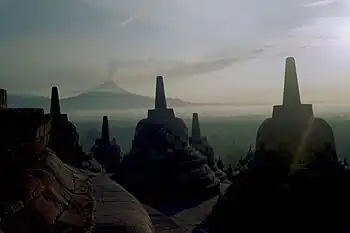
Understand
History
There is no definite written record of who built Borobudur or why it was built. It was likely founded as a religious site in the 8th century at the peak of the Sailendra dynasty in central Java. The construction is thought to have taken a period of 75 years, and completed in about 825 AD.
The details of Hinduism and Buddhism from this period in Java's history can be baffling for visitors. Together with the records of many royal marriages between Hindu and Buddhist nobles, many Hindu and Buddhist monuments were constructed in the region at this time. Borobudur and the nearby Hindu Prambanan temple complex were more or less contemporaneous.
A common thread of stories suggest that Borobudur lay abandoned and hidden for centuries under layers of volcanic ash and thick jungle growth. Popular theories are that the local population just became disinterested when there were mass conversions to Islam in the 15th century, or they were simply driven away by a large volcanic eruption. It was never forgotten entirely though, with local folklore ensuring that stories of the great monument lived on.
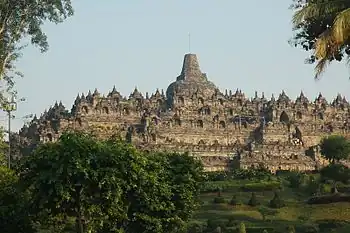
Rediscovery
Following the Anglo-Dutch Java War, Java was briefly under British administration from 1811 to 1816. The British governor was Thomas Stamford Raffles (the founder of Singapore), and he took a great practical and academic interest in the history of the mystical island of Java. On a tour to Semarang in 1814, he was informed about a huge ‘lost’ monument deep in the jungles near Yogyakarta, and he sent a Dutch engineer to investigate. It took two months to clear the jungle and partially reveal the amazing monument, but it was not until 1885 that the complex was unearthed in its magnificent entirety. Raffles also presided over the re-discovery of nearby Prambanan, and it is somewhat ironic that the very brief British rule of Java led to the uncovering of both these ancient monuments.
Appreciation and protection was surprisingly slow to develop, and Borobudur became the domain of unscrupulous souvenir hunters. Modern-day archaeologists speculate that this was due to the European obsession with Ancient Egypt at the time — Borobudur was just too remote and too far away to get the attention it undoubtedly deserved. There was even a Dutch proposal to dismantle the monument and scatter it piece-by-piece to museums around the world.
Thankfully, good sense prevailed and by the end of the 19th century the site was left largely intact and as importantly, extensively photographed, and a five year restoration programme was undertaken in 1907.
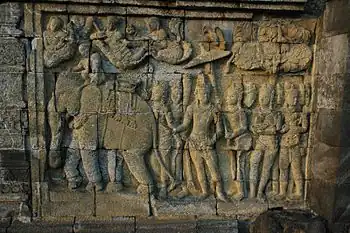
Modern day Borobudur
In 1956 UNESCO began an assessment process for the full scale restoration of the monument. Finally in 1968, a major plan to restore Borobudur was created, and this huge project involved a complete overhaul of the monument up until 1983. The unsteady foundations were stabilised, everything was meticulously cleaned and a major drainage system installed. After the works were finished, UNESCO formally listed Borobudur as a World Heritage Site in 1991. Since then, the profile of Borobudur has increased enormously, and it is now a major international tourist attraction. Its statues, reliefs and stupas have spawned millions of replicas which adorn properties worldwide.
This huge popularity has its downsides. Deliberate vandalism and general wear and tear are of great concern for the future integrity of the monument.
As well as being the most popular tourist attraction in modern day Indonesia, Borobudur has resumed its role as an important place of worship and pilgrimage for Indonesian Buddhists. Visitors should be understanding and respectful of this, especially during major Buddhist holiday periods.
The 2006 Yogyakarta earthquake which badly damaged nearby Prambanan, left Borobudur unscathed.
The 2010 eruption of Mount Merapi
Borobudur was heavily affected by the eruption of Mount Merapi in October and November 2010. Volcanic ash from Merapi fell on the temple complex, which is approximately 28 km (17.5 mi) west-southwest of the crater. During the strong eruption of 3–5 November for example, a layer of ash up to 2.5 cm (1 in) thick fell onto the temple. This also killed nearby vegetation. Experts feared that the acidic ash might severely damage the historic site.
UNESCO donated US$3 million as a part of rehabilitation costs to rid the temple's stones of volcanic sediment, then to plant trees to stabilise temperatures, and finally to support the living conditions of local residents. More than 55,000 stone blocks from the temple structure had to be dismantled to enable restoration of the drainage system, which had been clogged by slurry after rains.
Orientation
Borobudur lies in the Kedu Plain - a very fertile volcanic plain between the twin volcanoes of Mount Sumbing and Mount Sundoro to the west, and Mount Merbabu and Mount Merapi to the east.
Visit time
Borobudur is not only a favorite of foreign tourists, but also domestic tourists, mainly students of all ages, usually in May and June. If you are planning a visit, try not to visit during school holiday season, it is worth investigating those dates. Another date in the Indonesian calendar to consider is that of Idul Fitri and up to a week after.
Information office
- PT Taman Wisata Candi Borobudur Prambanan Ratu Boko, Borobudur Temple Unit Office, Jl Badrawati, Borobudur, ☏ +62 293 788266, borobudur@borobudurpark.co.id. Daily 06:00-18:00. The official government park authority for Borobudur.
Get in
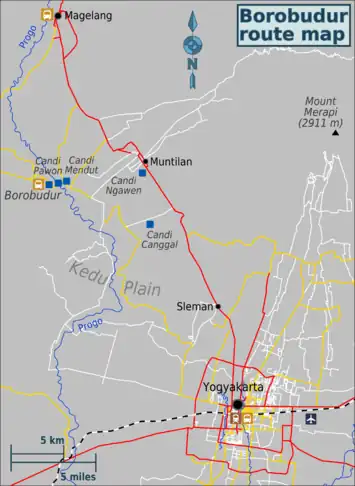
By plane
The nearest larger airports are Yogyakarta's Adisucipto International Airport (JOG) and Solo's Adisumarmo International Airport (SOC). Both are well connected domestically, and also offer some international connections to Singapore and Kuala Lumpur. AirAsia for example flies from Singapore to Yogyakarta daily.
It is possible, if you rush a bit, to visit Borobudur on a day trip from Bali or Jakarta. You can also fly direct to Semarang's Achmad Yani International Airport (SRG) with Air Asia from Singapore and Kuala Lumpur, and make your way to Borobudur from there (2–3 hours by road).
By bus
DAMRI runs bus service in the early morning and early afternoon from the central Yogyakarta bus station, near the south end of Malioboro (90 min, Rp 20,000). The schedule is posted on the @damriindonesia Instagram account, under the Yogyakarta story.
To get from or to the Hindu temples at Prambanan, take a Yogyakarta bus and disembark at Jombor Terminal (90 min, Rp 15,000 for foreigners, Rp 7,000 for Indonesians). From Jombor take TransJogya route 2B to Prambanan (45-60 min, Rp 3,000). It will require 3 bus changes: 2B from Jombor to Terminal Condong, 3B from Terminal Condong to Maguwo (Jl. Solo) and 1A/B from Maguwo to Prambanan.
Buses run regularly from Magelang to Borobudur via Muntilan and are widely advertised there. The journey time is about 1 hour.
By minibus
Travel agents in Yogyakarta sell door-to-door minibus tour packages for around Rp 75,000. This is a good deal and a straightforward way to reach the monument, although some operators may stop off at batik and silver factories along the route.
By car
Borobudur is about 40 minutes north of Yogyakarta by car. Most of the route is on a well-maintained (for Indonesia) four-lane (in many places) highway, and there are frequent bus services (see above). A taxi from central Yogyakarta to Borobudur costs around Rp 200,000, and from Yogyakarta airport about Rp 225,000.
By train
The nearest stations are in Yogyakarta which is the major rail hub of Central Java. Connections are frequent from major cities in the west such as Jakarta and Bandung, and in the east such as Surabaya. From the main Tugu station, the only direct options to Borobudur are taxi or private bus transfer. The cheapest option is to take a local minibus (if available) or motorbike taxi (Rp 15,000) to Jombor bus terminal, where local buses depart regularly for Borobodur (Rp 20,000).
Get around
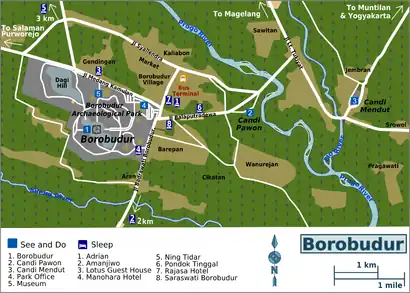
The only practical means of getting around Borobudur is on foot. A toy train of limited practical use shuttles around the temple, and between the museum and entrance gate for Rp 5,000.
If you are staying in the area, most local hotels and guesthouses will rent bicycles for about Rp 30,000-50,000 per day. This is a good way of exploring the other sights and local villages around Borobudur.
To get out go to the main entrance. Be wary of the Exit signs as they lead to a maze of souvenir stalls.
Fees and permits
The site is open from 06:00 to 17:00, every day except Monday.
The standard entry ticket only includes the grounds surrounding the temple, and no longer includes access inside or to the top. As of April 2024, it costs:
- $25 (~Rp 400,000) for adult non-Indonesians
- $15 (~Rp 240,000) for non-Indonesians aged 3-10
- $15 (~Rp 240,000) for non-Indonesian registered students (letter of introduction from university or college is required)
- Rp 50,000 for adult Indonesians
- Rp 25,000 for Indonesians aged 3-10
Entering the temple requires a Temple Structure Ticket, which includes a 1 hour guided tour (English available) that goes inside and up to the near-top of the temple (Top restricted to Buddhist ceremonies). Only 150 tickets per hour are made available for the most-visited attraction in Java, so book ahead. Reservations can be made 7 days in advance from the official site https://ticketcandi.borobudurpark.com/en/tickets . The site may list multiple tours at the same price; the specific theme of the tour doesn't seem to matter.
- Rp 455,000 for adult non-Indonesians. (Apr-2024)
- Rp 305,000 for non-Indonesians aged 3-10
- Rp 120,000 for adult Indonesians
- Rp 75,000 for Indonesians aged 3-10
- Rp 17,000 online service fee
Online Mandala and Mahakarya type tickets are same.
Combination tickets for Borobodur, and other local sites (Prambanan, Ramayana, Mendut, Ratu Boko, and Pawon) are available. Borobodur & Prambanan is 720,000 for foreigners (Apr 2024). The combination ticket doesn't combine with the Temple Structure tour or other temples like Ratu Boko.
Visitors are not required to wear a sarong whilst visiting the temple, but some footwear is prohibited to protect the temple from erosion. Cheap sandals are provided for the Temple Structure tour and left to visitors after tour.
The main site is approached through a large open and pleasant park inside the complex. The exit is constrained through a souvenirs stalls path.
See
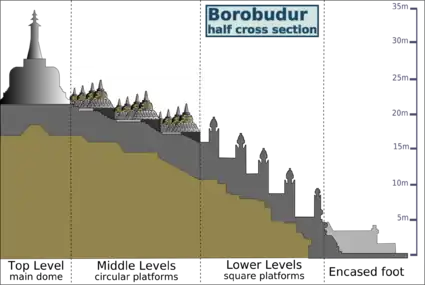
- 🌍 Borobudur. Borobudur consists of six square platforms topped by three circular platforms, and is decorated with no less than 2,672 relief panels and 504 Buddha statues of various types. The main dome, located at the centre of the top platform, is surrounded by 72 Buddha statues seated inside perforated stupas. The square base is 118 m (387 ft) long on each side, and the highest point 35 m (114 ft) above ground level.The whole monument is constructed from dark grey andesite stone, and so synonymous has this become with Borobudur and other temples on the Kedu Plain, that Indonesian for the material is simply batu candi (temple stone). The single structure can be divided into layers as follows:. (updated Aug 2019)
- The platform or foot at the base of the structure, which was clearly post the original construction and hides some reliefs, is of uncertain provenance and function. The main theories are that the platform was added to censor reliefs depicting earthly desires or — rather more likely — to buttress the subsiding structure and prevent it from collapsing. A section of the platform has been excavated at the southeast corner, showcasing some of the hidden reliefs underneath.
- The bulk of the structure consists of six square terraces connected by steep staircases. Each terrace has reliefs in two layers on both sides, recounting the story of the Buddha's past lives and his enlightenment.
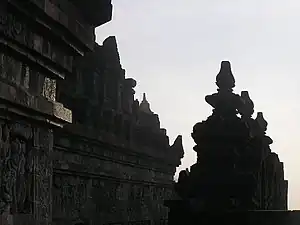
- Above the square terraces, the structure opens up to reveal the final three circular terraces. Comparatively plain and unadorned, there are no more reliefs here just seventy two lattice work stupas — domes housing half-hidden Buddha statues (many headless, some lost entirely). A bombing some years ago destroyed nine of them, but they have been well restored.
- The peak of the structure is a central stupa. The two chambers inside the stupa are empty, and it is unclear whether they were empty from the beginning as a representation of nirvana, or whether they originally contained statues which were looted or lost. The site museum contains what might be a missing statue.
The monument's three divisions (the square terraces and central stupa at the peak are regarded as one division) symbolise the three realms of Buddhist cosmology, namely Kamadhatu (the world of desires), Rupadhatu (the world of forms) and Arupadhatu (the formless world).
There are six different postures of Buddha's statue from the bottom level to the top. These are contact with earth, giving and helping, meditation, fearlesness, teach and learn and turning the wheel of dharma.
The wall reliefs
You can think of Borobudur as a very large teaching graphic recounting the life story of the Buddha, his teachings and his progress towards Nirvana.
In summary, the 2,760 reliefs tell four key sets of stories in the form of carved illustrations and Sanskrit inscriptions:
- The law of karma or Karmavibhangga. These are mostly hidden by the post-original construction masking at the foot of the monument. The reliefs tell stories and give examples of the nature of karma with depictions of both praiseworthy (including co-operative working practices and planned parenthood) and blameworthy (including torture, rape and theft) activities. The masking was disassembled in 1890 before being painstakingly rebuilt, and photographs were taken of the reliefs at this time. These photographs are displayed in the Borobudur Museum.
- The birth of Buddha or Lalitavistara. Before the story starts, there are 27 panels showing preparations for the final earthly incarnation. The story then begins with the descent of the Lord Buddha from heaven, and continues until his first earthly sermon as Prince Siddhartha.
- The Jatakas and avadanas. Jatakas are stories about the Buddha before he was born as Prince Siddhartha. Avadanas are similar to jatakas, but the main figure is not Buddha himself. Both are depicted in the same series of reliefs.
- The journeys of Sudhana searching for ultimate truth or Gandavyuha. This is the story told in the final chapter of the Avatamsaka Sutra about Sudhana's tireless wandering in search of the highest perfect wisdom.
Sunrise
Normally around 5h30, to best see sunrise you have to go to a little hill (see 🌍 Sunrise Point) near by Manohara Hotel, be aware of the people that will try to guide you there if you don't know the way (if you agree, you can pay them no more than Rp. 10,000). The entrance to the viewpoint is 15,000rp for locals and 30,000 for foreigners. Normally by motorbike it takes 1 hr 15 min-1 hr 30 min from Yogyakarta.
However, the Manohara Hotel (see Sleep) runs a daily Borobudur Sunrise Tour for Rp 320,000 for foreigners (Rp 185,000 if you are a hotel guest) and Rp 220,000 for Indonesians, which gets you a flashlight and a lift up to the temple gate at 04:30. This is in time to see the sunrise, and to explore for an hour and a half before the hordes arrive. This is well worth the money. The sun rises in the same direction as the entrance you used to gain access to the temple.
The Borobudur Museum
There are two museums in Borobudur Archaeological Park, the Karmawibhanga Museum and the Samudraraksa Museum. These museums are housed inside the park just a few hundred metres to the north of the temple. These museum ticket are already included within the Borobudur entrance ticket, so visitor are free to enter the museum. The museum is open daily 06:00-18:00 and entry is included with the main Borobudur ticket.
- 🌍 Karmawibhanga Museum. The Karmawibhanga Museum displays archaeological findings around Borobudur, the restoration process, as well as the photographs of Karmawibhanga relief on the hidden foot of Borobudur. It does a sometimes haphazard job of presenting the restoration process. Perhaps the most interesting exhibitions about this are those of the law of karma reliefs, with explanatory comments, and the photo gallery of late 19th-century shots of the complex before it was restored. (updated Aug 2019)
- 🌍 Samudraraksa Museum. The Samudraraksa Museum displays the actual size replica of Borobudur Ship. It also displays the maritime technology and trade network of 8th century Asia and Africa, especially the maritime trade of Indian Ocean. In 1982 a British naval history scholar called Philip Beale was visiting Borobudur when he noticed 10 panels depicting ocean-going ships. He surmised that these ships may have been a part of a famous shipping route — the Cinnamon Route — that linked Indonesia to Africa many centuries earlier. This led Beale to build a model ship based on those depictions, and that is now housed in its own dedicated space within the museum. (updated Aug 2019)
Around Borobudur
Between Yogyakarta and Magelang lies the volcanic Kedu Plain. This was clearly an important area in pre-10th century Javanese history as it contains a whole host of ruins (both Buddhist and Hindu) dating from the same era as Borobudur, and easily reached from there. If you have a car, the most accessible of these together make an interesting use of the late part of the day on the way back to Yogyakarta after you have seen Borobudur. Alternatively, if you are staying in the Borobudur area, rent a bicycle and explore these temples together with the verdant local countryside.
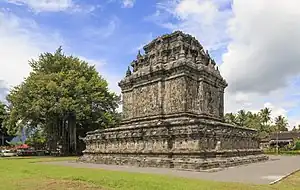
A combined ticket for entrance to both Candi Mendut and Candi Pawon costs Rp 3500. You should be able to visit any of these in the hours of daylight.
- 🌍 Candi Mendut (from Borobudur head back towards Muntilan on the main road for 3 km (1.8 mi), and Candi Mendut is signposted off a small left hand turn off the main road). A Buddhist temple that is thought to have acted as a way-point on the road to Borobudur. It was first discovered in 1834 and holds the distinction of being the first ancient monument in the whole of Indonesia to be restored (from 1897). Some of the statues and reliefs here are of the highest quality, and it is well worth a visit. Mendut is notable as the start of the modern day Waisak procession.
- 🌍 Candi Pawon. It is only 2 km (1.25 mi) from Borobudur and you cannot miss driving past it when heading back towards Muntilan and Yogyakarta. Candi Pawon and Candi Mendut are on a perfect straight line with Borobudur. This temple was restored in the early 20th century.
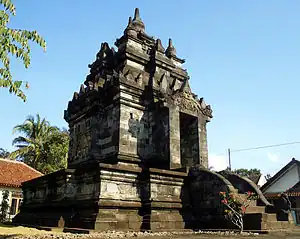
- 🌍 Candi Ngawen. It is in Ngawen village just to the south of Muntilan on the main road heading towards Yogyakarta, about 15 km (9 mi) from Borobudur. This Buddhist temple dates from 824 AD, and has some interesting wall reliefs.
- 🌍 Candi Gunung Wukir (Candi Canggal). It dates from the 8th century, and is at Gunung Wukir on the main road heading back towards Yogyakarta from Muntilan. The best landmark is the Chinese cemetery which you should look for on the right after leaving Muntilan. A road leads west (right) just after you pass this cemetery. Follow this until the end and walk the last few minutes to Candi Canggal.
Do
If you are still at Borobudur in the late afternoon, return to the top level for sunset. It is often very quiet at this time, and the sunset behind the mountains to the west is scenic.
Festivals
- On Waisak, Buddha's birthday (held on the night of the full moon in May), an elaborate and colourful multi-day Buddhist festival is held at Borobudur, culminating in a candle-lit procession from Candi Mendut to Borobudur. If you are lucky enough to be visiting at this time, the procession is magical event to witness. At other times, just walking the Waisak procession route from Borobudur to Candi Mendut (or vice versa) is an excellent experience.
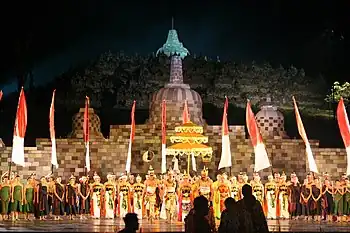
- Every June, the park authority arranges a performance of the Mahakarya Borobudur. This ballet uses traditional Javanese dance to tell the story of the conception and construction of the temple. The event takes place at the Aksobya open theatre against the backdrop of Borobudur, and is a lavish production. Tickets Rp 300,000-800,000.
Buy
Persistent touts hassle tourists on the approaches to the temple but are usually kept away from the temple itself. Be firm and polite about your intentions and they will soon get the message. Be careful when you exit the temple as there are confusing signs pointing to exit gates which lead you through a maze of stalls. If you want to avoid the maze of handicraft stall, do not turn left and follow the nearest exit sign, just move straight forward to the exit located nearest to the entrance.
If you do intend to buy some souvenirs here then make sure your bargaining skills are at their best. Pedlars sell small statues that they claim are carved from lava stone, but most are cast coloured cement. Identifying genuine lava stone is easy enough as the stone is quite light for its size compared to the weightier concrete. Nonetheless, if a concrete Buddha head will suffice you should not pay more than Rp 20,000. Their first offer is around Rp 150,000. Just tell them, that you already bought for Rp 20,000 and they will give you this price. An authentic lava stone version carved by a skilled craftsman will cost, and be worth, considerably more.
Should you be in need of cash, there is a Bank Negara Indonesia (BNI) ATM close to the main park entrance.
Muntilan
Muntilan is a market town on the main route from Yogyakarta to Magelang. When leaving Borobudure, Muntilan is 13–14 km (8.5 mi) back towards Yogyakarta on the main road (Jalan Magelang).
It is also where transport for Borobudur turns off the main road, and it has developed as a leading manufacturing centre of carved stone Borobudur replicas.
As a typical market town in Central Java, it is worth walking along the main street to have a sense of where tourism has not taken over completely, as most tourists rush through, a significant number of adjacent villages and areas treat this as their market town, and it is possible to see the businesses and people who rely on Javanese custom, rather than tourist. In most cases though, the food stores will still provide tourist food, rather than what the local eats, you would need a Javanese or Indonesian friend or guide to specify you want to eat local.
Muntilan is also a significant Roman Catholic heritage site, being the location of the Van Lith mission in the nineteenth century, it is also the place where senior members of the Jesuits who served in Yogyakarta and Central Java are buried.
During the second world war, Muntilan was the site of a Japanese prisoners camp.
While very few tourists ever consider the back roads to the western slopes of Merapi, most roads that lead up to the western and north western slopes, and village area, leave from Muntilan. Also if you are using 'local' transport rather than Borobudur specific transport, the stopping place at the markets is where you change transport. It is possible to catch Magelang and Semarang bound buses at this point as well.
If you are thinking of buying a stone Buddha, stupa or wall relief, this could be your port of call.
Eat and drink
The bus station area is home to a multitude of hawker stalls selling standard Indonesian street food and all manner of drinks. Be aware that most close by 17:00.
Otherwise the only dining options are in hotels. Manohara Restaurant, inside the grounds of the hotel of the same name, serves up standard Indonesian fare while offering beautiful views of Borobudur. Mains from about Rp 25,000. Amanjiwo has truly spectacular food at even more spectacular prices.
Sleep
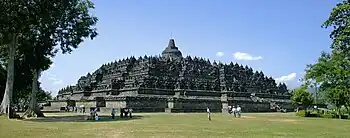
The vast majority of visitors stay in Yogyakarta and a few in Magelang. It is though well worth spending the night at Borobudur as this will give you a chance the following morning to get to the temples before the crowds arrive. Indeed, if you really want to explore and understand this magnificent monument, over-nighting in the immediate area is vital.
Budget
There are a few losmen (guesthouses) and basic hotels in the village of Borobudur just south of the park entrance. Owing to the site's popularity with tourists prices are, by Indonesian standards, somewhat inflated for what you get.
- 🌍 Lotus 1 Guest House, Jl Medang Kamulan 2 (on northern road near Borobudur), ☏ +62 293 788281. Check-out: 12:00. Popular amongst backpackers and offers the usual Indonesian budget set-up. Lotus I is just 100 m from the entrance of Borobudur, and the late checkout is perfect for spending the morning at the temple. Good, cheap Indonesian food available until 21:00. Organizes tours for Hill sunrise view on Borobudur (Rp130,000) and offers a 15% discount on the temple entrance fee. Possibility to book the sunrise entrance for Rp380,000. Closed. See Lotus 2. From Rp100,000 (basic double room during low season) to Rp350,000 (family room with air-con and hot water during high season and holidays). Includes a simple breakfast. (updated Apr 2024)
- 🌍 Lotus 2 Guest House, Jalan Balaputera dewa no.54 Cawang Sari, Dusun XVI, Borobudur, Kec. Borobudur, Kabupaten Magelang, Jawa Tengah 56553, ☏ +62 857-4341-6286. Check-in: 14:00, check-out: 12:00. Room from Rp 250,000. Includes breakfast. (updated Apr 2024)
- 🌍 Pondok Tingal, Jl Balaputradewa 32, Brojonalan (on the eastern road entry, between Borobudur and Candi Pawon), ☏ +62 293 788145, info@pondoktingal.com. Good value option less than 1 km from the entrance to Borobudur. From Rp200,000.
- 🌍 Rajasa Hotel, Jl Badrawati No. 2, ☏ +62 293 788276. Only about 200 m from the main entrance. Very popular with Indonesian families and the walls are thin, so it can get noisy. Good service and food for the price. From about Rp300,000.
Mid-range
- 🌍 Rumah Boedi Private Residences, Tingal Wetan, Wanurejo (2km from Borobudur), ☏ +62 293 551-6000, fax: +62 293 788698, info@rumahboediborobudur.com. Check-in: 14:00, check-out: 12:00. Individual villas in a rural setting with views of Mt Merbabu and Mt Merapi. Rp500,000.
- 🌍 Sarasvati Borobudur, Jl Balaputradewa 10, ☏ +62 293 788843. This is a beautiful hotel with views of Borobudur, a swimming pool, and gracious staff. The rooms are large with the full range of amenities. Room rates are often deeply discounted (up to 60%) so be sure to ask before you go. Breakfast is included in the rate as is transportation to Borobudur. A guide is an optional extra. Rooms from Rp640,000.
- 🌍 Omah Eling Guesthouse & Art Gallery (Omah Eling), Jl Medang Kamulan No 1, ☏ +62 293 789534, omaheling.hotel@gmail.com. Check-in: 14:00, check-out: 12:00. Rp475,000. (updated Apr 2017)
Splurge
- 🌍 Amanjiwo (3 km (1.7 mi) from Borobudur on the temple's south side), ☏ +62 293 78833, amanjiwo@aman.com. Resort run by the Aman Group. If you can't afford to stay here, try to find the money to have lunch or dinner which are worth it for the awe-inspiring vista alone. from Rp6,500,000. (updated Jul 2021)
- 🌍 Manohara Hotel, Jl Badrawati, ☏ +62 293 788680. This friendly resort-style hotel is located inside the Borobudur Park, run by the park authority, and is 200 m from the temple entrance. The grounds are beautifully landscaped and the views are great, but the rooms are little more than functional with air conditioning, hot water and passable bathrooms. The real reason to book here is the Borobodur Sunrise package, which costs an extra Rp. 500,000 per person, but gets you into Borobudur at 04:30, a full hour and a half before the public gate opens. From Rp 1,700,000.
- 🌍 Plataran Borobudur Hotel (Plataran Borobudur Resort & Spa), Dusun Tanjungan, Borobudur (1.5 km from Borobudur area (You can reach the temple area in less than 5 minutes)), ☏ +62 293 788888, fax: +62 293 788699, info@plataranborobudur.com. The resort offers an outstanding view of Borobudur Temple, Mt Merapi, Menoreh Hill and is surrounded by lush teak forests. from Rp1,400,000.
Respect
Be nice to the locals. Seriously. There is a lot written in travel guides about the pushy nature of the vendors at Borobudur. And they can be a little annoying it must be said. But a few friendly no's and keeping on walking usually does the job.
Yogyakarta is a student town with many colleges and universities, and you will often find many students at Borobudur who are keen to be friendly with you. Take this how it is meant; they are genuinely friendly, and rightly very proud of their heritage and keen to talk to you about it.
To avoid the largest crowds, skip weekends when large numbers of domestic tourists visit, along with the occasional school trip of students, sent by their teachers to practice their English on overseas visitors. Alternatively, visit as early as you can in the morning.
If you look like a typical Westerner, you'll become a "tourist attraction" to school students instead of the temple itself. Expect to be filmed or audio recorded as students ask you all sorts of harmless questions - then they will ask for a photo with you. They are highly appreciate any kind of your interaction with them.
Connect
There is a public telephone office (Wartel) on Jl Pramudyawardani opposite the main market, and also a post office adjacent.
The telephone area code for Borobudur is the same as Yogyakarta - 0274
- Ambulance, ☏ 118.
- Police, ☏ 110.
Go next
- The Hindu temples of Prambanan, about an hour away by car, make the perfect complement to Borobudur.
- The cultural splendour of Yogyakarta is about 90 minutes by bus.
- The Dieng Plateau is a volcanic area in the highlands of Central Java with the oldest standing temples in Indonesia, pre-dating Borobudur by some 100 years. About a 90 minute drive to the northwest.
- If you want to see a serious active volcano, Mount Merapi is about a 2 hour drive to the east.
However if you are based in Yogyakarta or other locations and not driving yourself , there are 'tours' or 'climbing' ventures, that in most cases leave from Yogyakarta, and drive to Selo (located in the valley between Merbabu and Merapi) which is a traditional location to walk to the top of Merapi in the middle of the night for the dawn views.